Rimma Gerlovina and Valeriy Gerlovin
pHOTORELIEFS
© 2010, Rimma Gerlovina and Valeriy Gerlovin
part 3: circles
There is no straight line as such: if one draws a line continuously over the surface of the Earth, it will be a circle. So we worked with circles. Some of these circles are flat, as in the abbreviated round table IOU (1989, see Photoglyphs, part 3), while others are made as three-dimensional objects. One of the latter, Point, clearly relates to the Hindu concept of bindu, or third eye, the point of connection with the higher order of life. Traditionally, that unified “cyclopic” eye was associated with the pineal gland, atrophied in the vast majority of mankind. The power of pineal secretions, analogous to the elixir of life or the philosopher’s stone, bestows increased brain capacity, clairvoyance, and much more. That cognitive explosion leads to entirely new ways and speeds of learning, as well as certain commonly called magical ability. To calibrate it further, that is supposed to be an integrative cognition of the extra dimensions of the human consciousness that goes beyond the intellect.

Rimma Gerlovina and Valeriy Gerlovin, Point © 1991-92, C-prints in metal construction, 46½ x 46½ x 3½". Collection of Ackland Art Museum, Ackland, NC. Below: the announcement for the exhibition Up Close and Personal at Ackland Art Museum (from left to right) fragment of work by Chuck Close, fragment of Point, and the photograph of Walt Whitman. |
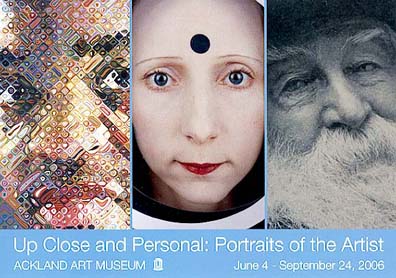
The mystery behind the third eye opening was traditionally connected with the endless process of training the mind in the art of clear thinking, meditation, and silence. The unenlightened mind is but thick grey matter: it simply swallows up all information into obscurity and dullness, much like how the stomach digests food. The mind is the sphere of duality, in fact, consisting of the two spheres of the brain. We cannot join them simply like two balls of dough; they have to be united with mental and spiritual acuity in such a gradual, intricate way that the mind could be able to acquire certain supra-mental abilities. But what the mind is capable of doing does not necessarily mean it is doing that. One might more easily train a monkey to perform basic processes of human reasoning than untrain a human to reason by means of the habitual functions of his mind, its dissipating worldliness, pseudo-useful curiosity, and excessive debilitating practicality. If one is not to merge into some sort of an engulfing collectivity, the customary way of thinking must be reinterpreted. Naturally, mind training and observation of thought process will wander through the circuitous path of struggle with unworthy opponents and a variety of distortions. In addition to that, the brain is able to create a sophisticated confinement for the intellect, gradually acknowledging that the power of reasoning is not equal to the power of knowledge.

| Rimma Gerlovina and Valeriy Gerlovin, Orbit © 2008, C-print in aluminum construction |
Similarly, by tracing the infinite in the infinitesimal, the human mind might be compared to its prototype – the creator’s mind, which, in the definition of Aristotle, “thinks, and its thinking is a thinking of thinking." 8 Mind continuously creates its own environment. Therefore, the surrounding world does not only exist independently from us, but it is also the result of our consciousness. Often, external events are part of our destiny as well as our own temperament. In addition, the machinery of cognitive faculty has its “share” of the sense organs. Their circuit of external and internal influences can cloud the intellect and forcibly drag away the mind even of the wise into the web of illusions.
And yet the participation in the world extravaganza helps man to realize his destiny and the meaning behind it, and possibly to transcend all process. “Who has overcome the world? He who has conquered his own mind.” (Shankara) 9 This very mind, which at a small scale is the issuing point of the creation of thoughts and ideas, is the fecundation principle as well.
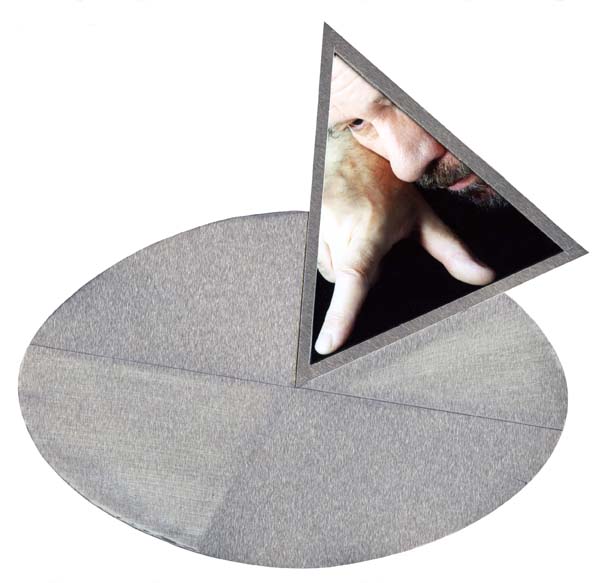
| Rimma Gerlovina and Valeriy Gerlovin, Sector © 2008, C-print in aluminum construction |
As always, art is a useful instrument for revealing the path to the higher intuition able to operate like a metaphysical telescope through which one can see to infinity. Thinking along those lines, Nietzsche anticipated the advent of the “artistic Socrates.” 10 The syncretism of the mental and the aesthetic seems to hold the key to one of the many secrets of quintessence, the tapping of which remains mainly a riddle until one obtains it personally. Perhaps that’s why Socrates himself admitted that he knows that he knows nothing. As for us, we do not even know whether we know or not. What is clear is that our ever-changing forms of insight are not insight itself. Therefore, one must use the mind to go beyond the mind.
There’s an ultimate inclusive source of life that contains all our lives as sumum bonum. That point is everywhere and in every “when,” even being seen from different perspectives. In reality, life is subjective and objective at all levels. What this means in terms of humanity is that the mind is more faithfully integrated with the supreme identity of being when ego ceases colonizing the consciousness. That is difficult to grasp, and yet it could be true.

Rimma Gerlovina, Level: The palindrome is written on three circles, two of which can be rotated, 1988, plywood, acrylic 17½ x 17 ½ x 4" |
The principle of the coincidentia oppositorum and its balancing unity is not a synthesis obtained by reason; therefore it is always better to resort to symbols and art. Before assuming an anthropomorphic form, the concept of balance was explored in Rimma’s visual poetry in a three-dimensional form, of which the wooden relief Level would be a good enough example. The skill of equilibrium was known as the key to mastering occult science and life in general. The unbalanced forces can be easily dissimilated, which that wooden relief harbors as a possibility. Rotating the circles with letters, one can “dislevel” its symmetrical arrangement into a mess.
All of the Photoreliefs rest upon the law of symmetry and balance, especially the metal constructions with the male images. Nature “geometrizes” and equilibrates, so we try to follow the same rules. Not only music but also poetry, art, and many patterns in nature contain equivalents to the principle of the harmony of spheres in Pythagorean terms. The photorelief Level is related to that concept in a particular way.
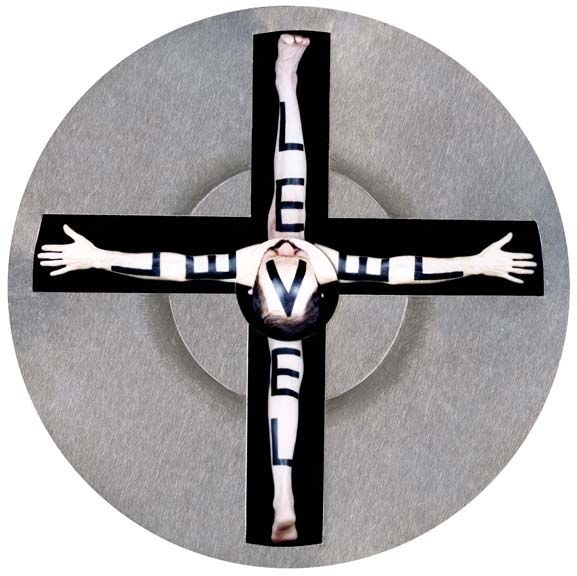
| Rimma Gerlovina and Valeriy Gerlovin, Level © 1991/2006, C-prints in aluminum construction |
Inserted into the centrifugal composition, the pacing “cross-figure” brings the opposing currents into focus and balance. The human figure seems to be placed on the wheels – “under the wings of the cross and under its arms,” in the apocryphal words. 11 The body is reduced to the primary bone constituents while the human proportions line up with the pivotal palindrome “level,” whose meaning is uniquely homological to its visual form. When “placed” on the cross, the word reads the same from all four sides. Its central “V,” the first letter of the artist's name written on his sinciput, is a conventional sign for victory. As the Roman numeral 5, “V” marks the fifth element, all centralizing quintessence, which is a balancing focal point of the quaternary. Uniting all vectors in the composition, the crown of the head suggests an image of the pivotal gate, through which the supreme force might enter into a control, stimulating the breakthrough into the communicating vision with the splendor of the world.
The rhythm of the composition follows architectural patterns akin to a cross-domed basilica; it is based on a circle and cross-in-square geometrical relationship. Aside from the religious meaning, the cross has many levels of interpretation: it symbolizes the quaternary seasonal movement of nature, encompasses time and space divisions, and carries the four-fold arrangements according to the elements, mythologized as the four horsemen of the Revelation, four evangelists, four suits of Taro, and so on. The left foot of our “compass” is shown down in the earth element, sunk in the world of actuality, the ordeal of matter. The right foot is in the air, pacing above. They are opposed, as air and earth, north and south. The arms keep the horizon of other symbolic pairs of duality, i.e., fire and water, east and west. The image is connected not only to the familiar principles of world navigation but is a reminder of the vision of Ezekiel, in which the quaternary operates as a wheel within a wheel. 12 Traditionally, the cross as an axisymmetric living circle carried the sacred meaning of the foundation and the framework of all constructions in life, including the essential one:

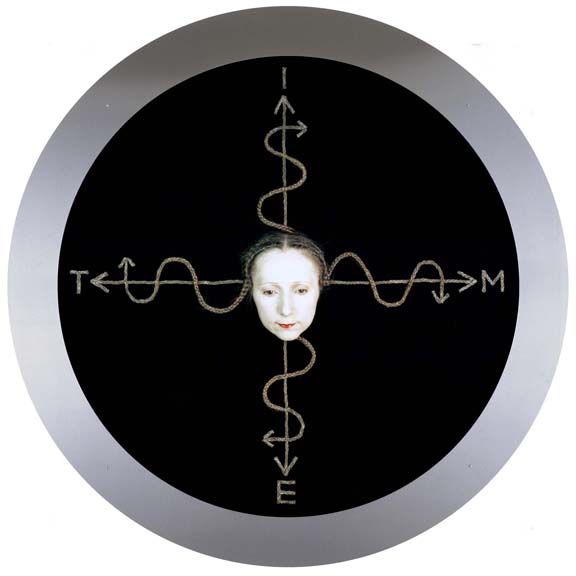
| Rimma Gerlovina and Valeriy Gerlovin,Time © 1992, C-print in aluminum frame |
Experimenting on human nature geometrically, we envisioned it on the cross of Time. Each I’m is a point fixed in t-I’m-e and space. One can take it optimistically, without reservations or consider oneself a tourist in one’s own life, look at it objectively and dispassionately, or with a tart pessimism, salty tongue, and hyperbolic self-pity while fancying oneself as a bit of a Hamlet.
“The time is out of joint. O, cursed spite
That ever I was born to set it right!” (Hamlet, II.1.185)
In the strictly symmetrical composition of Time, which incidentally is not “out of joint,” time and space overlap each other in sharing the vectors of a cross. They “go” hand in hand and toe-to-toe, encompassing and measuring our personal life, its ebbs and flows, to which inevitable surprises we try to adjust. It is not difficult to find narrative examples of the cross-current navigation in a mythological sphere. For instance, the pilgrimage to the Grail in the Arthurian cycle epitomizes the progression of consciousness through four emblematic essences wrapped around the cross. The quest itself already stirred up the opposing qualities of the quaternary reflected in the external and internal confrontation of a personality, such as thinking vs. feeling, idealism vs. materialism, and many other correlations in which negative dialectic is used in a positive way. To find the optimum point reaching perfect equilibrium, one has to acquire an incredible skill of carrying the cross of nature on one’s shoulders and to do so in such a way as not to identify oneself either with the cross or with nature in serving its blind carnal reasons.

| Rimma Gerlovina and Valeriy Gerlovin, Culmination © 1999, C-print |
The cross is also a hierogram – the earliest form of it is the
Egyptian crux ansata or ankh ![]() depicted
with a head and, in general, means “life.” According to the mysteries of the
cross in the early non-ecclesiastic tradition, the wheel with the cross “carried”
a man into the crush and crucifixion of his own low nature and after the
metamorphosis carried him back into the world of a perfected vision of life. A
man moves through these four elements in search of his own level, like a
rolling stone, which in due time might be transformed into the philosophers
stone, symbolizing an imperturbable and tranquil union of all opposites. When
the head acquires qualities of the heart, the elixir of life is produced, removing
the discord of the opposing forces of the terrestrial encompassing cross. The
ego willingly (though it may seem unwillingly, as at the scene of the agony at
the Gethsemane) enters the realm of power of the impersonal, suffers changes
and fusions that might be called “nuclear,” and as a result of the
metamorphosis becomes capable of transmitting the power of the impersonal
through itself. In due course, the inner work manifests outwardly; “knowing”
must end in “being.” The internal process of pregnancy with ideas slowly ripens
until the changes become obvious in all that one thinks, says, and sees around.
Then, living in the material world, one might be relatively free and detached
from it.
depicted
with a head and, in general, means “life.” According to the mysteries of the
cross in the early non-ecclesiastic tradition, the wheel with the cross “carried”
a man into the crush and crucifixion of his own low nature and after the
metamorphosis carried him back into the world of a perfected vision of life. A
man moves through these four elements in search of his own level, like a
rolling stone, which in due time might be transformed into the philosophers
stone, symbolizing an imperturbable and tranquil union of all opposites. When
the head acquires qualities of the heart, the elixir of life is produced, removing
the discord of the opposing forces of the terrestrial encompassing cross. The
ego willingly (though it may seem unwillingly, as at the scene of the agony at
the Gethsemane) enters the realm of power of the impersonal, suffers changes
and fusions that might be called “nuclear,” and as a result of the
metamorphosis becomes capable of transmitting the power of the impersonal
through itself. In due course, the inner work manifests outwardly; “knowing”
must end in “being.” The internal process of pregnancy with ideas slowly ripens
until the changes become obvious in all that one thinks, says, and sees around.
Then, living in the material world, one might be relatively free and detached
from it.
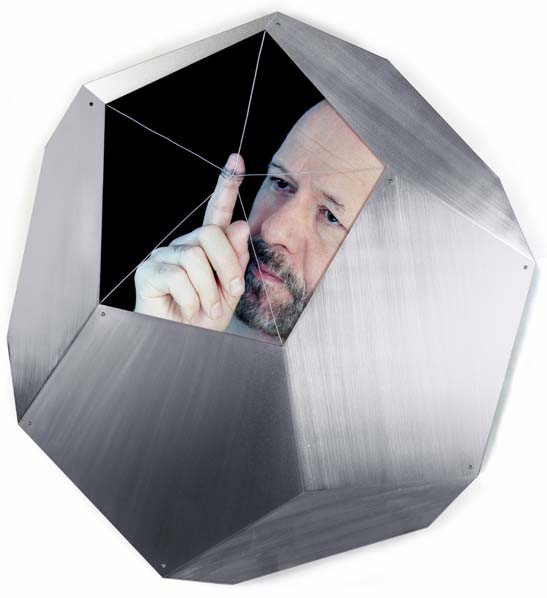
| Rimma Gerlovina and Valeriy Gerlovin, Dodecahedron © 2008, C-print in metal construction, engarving 37 ¾ x 35" |
Many of our concentric metal constructions are built around centralized images, as in Dodecahedron or Metal Glove. The dodecahedron, the most important and sacred Platonic solid, was associated with aether and quintessence or the power underlying the other four elements. The quintessence has no obvious physical manifestation, yet penetrates all three layers of existence simultaneously: latent unconscious, conscious, superconscious.
Everything in life seems to be united within the space-time continuum emanating out of some sacral center, to which the human soul continually aspires whether it knows it or not. Having neither beginning nor end, that focal point cuts through the entire universe and might be activated in the luminous center of human consciousness. “As all the spokes are connected both with the hub and with the rim, so all creatures, all Gods, all worlds, all organs are bound together in that Self,” reads the Upanishads.13
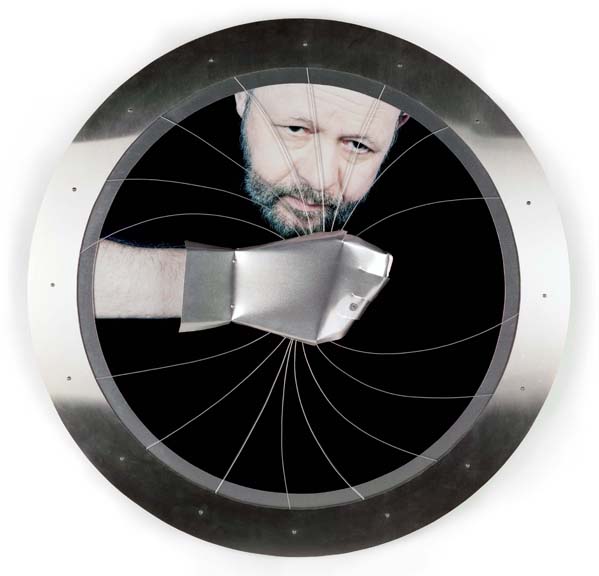
| Rimma Gerlovina and Valeriy Gerlovin, Metal Glove © 2009, C-print in metal construction, 36 x 36 x 2 ½" |
If the universe is the outcome and development of one Grand Thought all is coordinated according to the law of correspondences. As a fractal of the Whole, human mind participates in the overall process – mind forms the world. The wheel seemingly is speeded by our own free will. It might be so, yet not without reservations; according to Schopenhauer, we may have free will – but not the freedom to use it. Nevertheless, the human intellect can become a point of reflection for the universal law, reabsorbing the world of phenomena into the world of mind and vice versa.
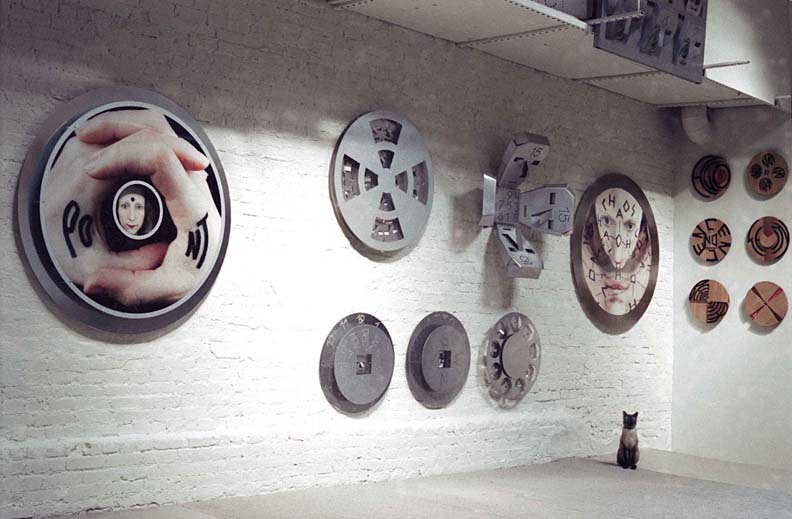
| Rimma Gerlovina and Valeriy Gerlovin, loft view, Spring Street, New York, 1992 |
In correspondence with the dynamic tendencies of nature that often operates in cycles, our move from the square forms to the circles was natural and timely for both of us. The perpetual process of circulatory dynamism is embedded in the immovable, and that is, perhaps, the binding idea behind Valeriy’s series of the round metal relieves. All of them feature circumscribed geometrical forms, transmuting numerological patterns into intuitive pictures.
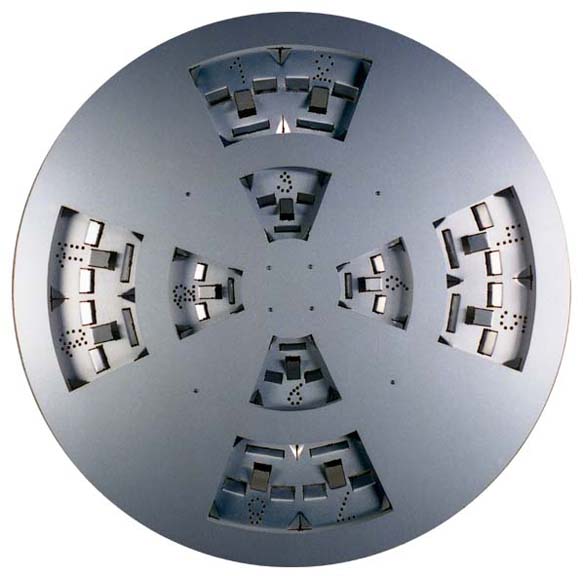
| Valeriy Gerlovin, Aztec Calendar © 1988, aluminum, 33 ½ in diameter, 3"deep |
In the numerological mandala Aztec Calendar, featuring the cut-out Maltese cross, the numbered faces are placed in the orifices, which four-partitioned arrangement corresponds to the four seasons. This geometrical “frozen-time” relief inherits something more than a title from the stony Aztec calendar. The symmetric matrix exhibits familiar fractal repetition, not only of faces but also of the recurring cycle of time and its unaltered sequence of the moving forces, symbolized by the numbers.
The celestial orders of harmonies is an endless hierarchy of unities, subdivided into other unities, and so on. Their symphonic arrangements are reflected in nature fractal displays, visual and performing arts, poetry, metaphysics, sciences, and what not. Take the case of the arithmetical numerological pattern:
1111111112 = 12345678987654321
That kaleidoscopic equation evokes some doubts as to whether it is real or just an ornamental appearance, so neat is it. The nine singles raised to the second power are equal to the chromatic sequence of the full set of numbers in their “roundtrip” from 1 to 9. In our imagination, we saw this arithmetical wonder together with the classical sign – the result was the circular composition Triskelion (“three-legged“ in Greek).
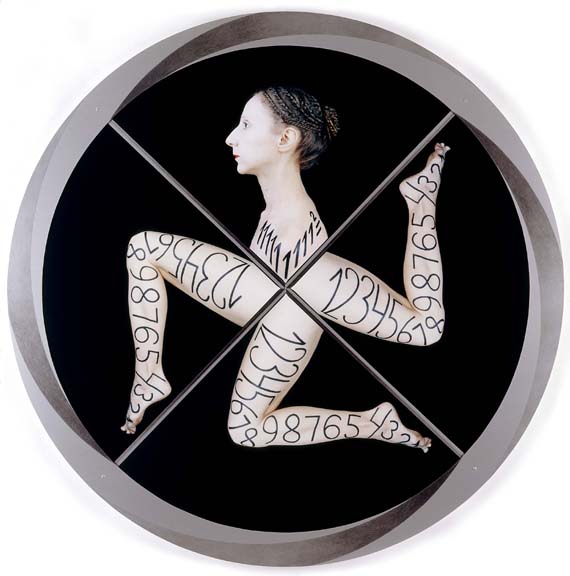
| Rimma Gerlovina and Valeriy Gerlovin, Triscelion © 1991, C-prints in metal construction, pencil drawing, 48 x 48" |
Inscribed on the three bent legs, the numerological scale issues from one point, forming a dynamic configuration. The bust figure bears the inscription of the nine ones. It seems to ride the tricycle of swastika while completing it’s forth wing with the profile. To paraphrase Katha Upanishad expression,
So long as a man is a man
His body is like a carriage,
His emotions are like a horse,
His soul is like a rider himself.
Aside from mythological interpretation, that equation in itself is a visual poetry of statistics, especially if we unwrap it into a full set of numbers showing the process of multiplication. The result is a harmonious sequence of numbers from 1 no 9 and backward.
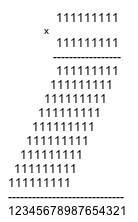
It is a picture of a life force of a hidden army of 1’s, an a cappella of 99 voices in a choir of 11 rows. There seem to be many riders in one carriage, and somehow their voices are unified in a single unit within one entity. And here again, we have to refer to the shape of the circle, which is a perfect in its way. Every point along its perimeter is at an equal distance from the center; hence all 1's exhibit corresponding equivalence in relation to their center and source. The circle is a metaphor for both limitless oneness and the cyclic nature of all that we observe around us, ourselves included.
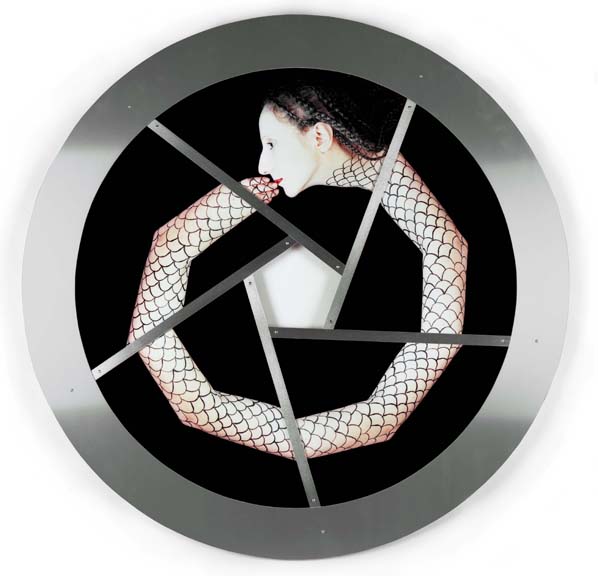
| Rimma Gerlovina and Valeriy Gerlovin, Ouroboros © 1994/2009, C-prints in metal construction, 45 ¼ x 45 ¼" |
The Ouroboros or snake eating its own tail (that’s what ouroboros means in Greek) is also a circle, perhaps in a somewhat devious sense. It’s an old symbol of self-generating and self-sustaining nature in the eternal cycle of renewal. Feeding on its own tail, this non-ending force prolongs the daydream of matter eternally while maintaining the circle of undifferentiated totality that, simply put, is a continuous, fundamental principle of life, with all of its bad and good connotations. That is a modem of nature that always survives its own burial, having both apocalypses and creation at the same time.
Physicists and other scientists theorize on the curvature of space-time. What if that space-time “bend” can curve until closing into a circle in which every cause produces the effect of its own effect? Is it the circle, in which “now” and “here” are linked into “nowhere,” and time is always “soon”? Yet, it is quite possible that despite its confinement in the space-time ouroboros, the human soul is unconfined. In that case, we may identify the soul as the idea of ideas, existing in that very moment as well in every other moment. It always is, being alive or dead in our understanding. However it might be, the ouroboros encompasses all that mystery within its end-negating circle.
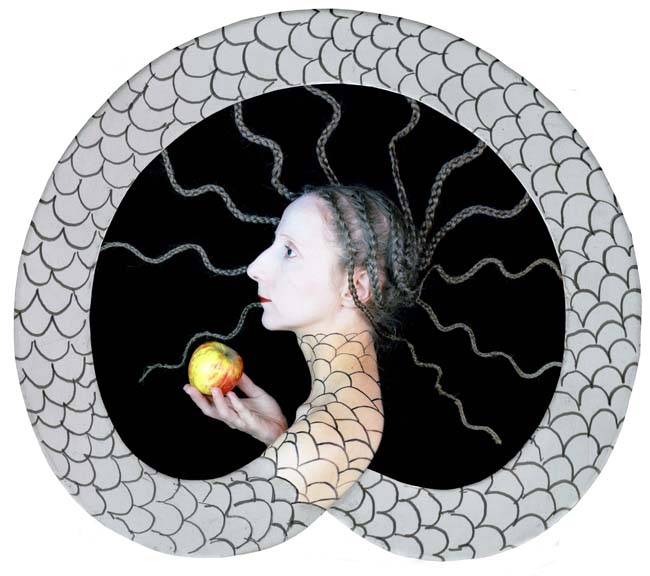
| Rimma Gerlovina and Valeriy Gerlovin, Ouroboros with Apple © 1994/2006, C-prints in metal construction |
Taking the form of the serpent, the ambitious reptilian force of nature encircles the tree of life in biblical paradise. We abridged the famous parable, fusing the serpent with Eve in the work Ouroboros with Apple. The process of “tail eating” in nature looks like a wanton waste of material: creating and killing without ceasing and without reverence to life destroyed. Instinctively proliferating, life lives on life. One species prey upon another for the sake remaining alive; in other words, surviving is predatory, often in a gruesome way. In that sense, the ouroboros is a collective image of all life that eats itself. Glittering and splendid, the serpent is symbolic guardian of these latent forces of nature and her alluring apples.
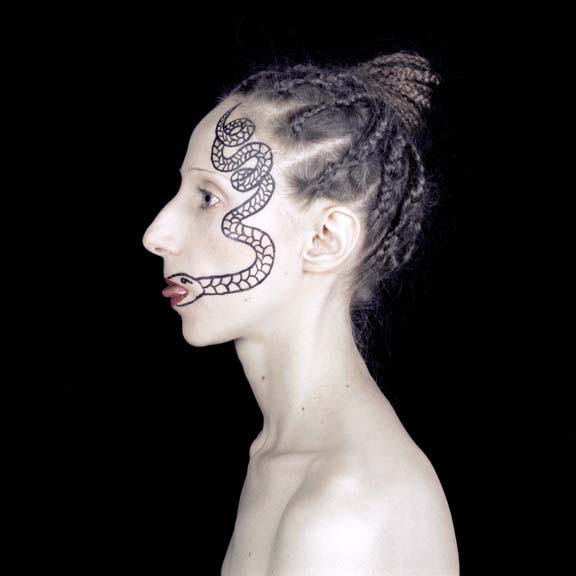
| Rimma Gerlovina and Valeriy Gerlovin, Serpent © 1989 C-print. Serpent was part of the international traveling exhibition Serpentiform, organized by Bulgari in 2016-17. (Further info...) |
Associated with its quicksilver tongue, serpentine knowledge is both illuminating and dangerous. Such was envisioned in the image Serpent, where it takes the form of the tongue, symbolizing among others logos spermatikos, or the fecundating word. It comes unto man as a lightning bolt of thought and speech. However, one thing seems to be certain that before the tongue can speak from a higher level of consciousness, it first has to lose the power to wound.
Snakes belong to the strange zoo of reptilian “omnipotence.” They shed their skin as if a sock and move without legs. A snake injects with deadly venom and kills, yet itself does not die from that venom. Moreover, snake’s pregnant dead body continues to hatch young snakes. Some female snakes can lay eggs without mating. Perhaps because of all these mysterious if not eerie qualities, this creature has been mythologized in all cultures. To penetrate its symbolism is like viewing thick layers of a thousand slides pressed together, meanwhile, our eye can distinguish only one at a time.